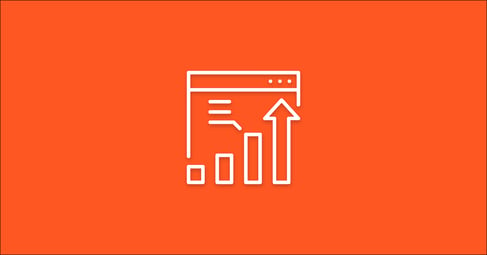Written By:
Kayley Blanchard
According to a recent study by SEMrush, 77 percent of companies say they have a content marketing strategy in place.
With each blog post, video, or image, these businesses are providing their audience with the information that they need and actively building trust. After consuming your content, these viewers are likely to move down the sales funnel and convert into paying customers. By publishing informative and engaging content, you’re strengthening your overall inbound marketing strategy.
Clearly, content marketing has the potential to be extremely effective, but only if you put in the necessary work before implementing your strategy. Goal-setting is a crucial and often overlooked step in the content marketing process.
Of course, you’re eager to get started on that next round of blog posts or videos, but you first need to set SMART goals using the appropriate performance metrics so you know what you’re working toward with your content. To set your goals and track your performance, you’ll choose Key Performance Indicators (KPIs) that you would like to improve.
Let’s take a closer look at what KPIs are and why they’re important in the context of content marketing.
What are KPIs and why are they important for content marketing?
Key Performance Indicators (KPIs) are quantifiable measurements that gauge your performance against your goals.
KPIs reflect the metrics that are most important to your organization, they measure your organization’s performance against business objectives or department-specific goals, and they indicate whether or not you’ve been successful.
To refresh your memory, all marketing goals should follow the SMART framework, meaning they are Specific, Measurable, Attainable, Relevant, and Time-bound. When setting your SMART content marketing goals, you’ll notice that SMART goals and KPIs go hand-in-hand.
Without KPIs, it’s impossible to have a specific or measurable goal since you won’t know exactly what you’re trying to achieve or how to measure your progress. By choosing KPIs prior to setting your content marketing goals, you’ll know exactly what you’re trying to improve through your content marketing efforts and you’ll be able to easily track your progress.
The specific KPIs that you choose for your content marketing goals will vary depending on your industry and your organization’s overall business objectives, but there are KPIs that we believe all content marketers should be tracking regardless of their industry.
The Content Marketing KPIs That You Should Be Tracking
1. Website Sessions
Your website performance directly reflects the quality of the content that you’re publishing. To gauge the performance of your website, you can take a look at Website Sessions.
Website Sessions refers to the total number of visits to your website, including new and repeat visits. A session runs from the time a user visits your website to the time they exit.
This metric is one of the most important for content marketers as it gives you a good indication of the effectiveness of your content marketing strategy. If your website sessions are decreasing or remaining stagnant rather than increasing, you’ll want to revisit and retarget your content so that you can make any necessary optimizations for SEO purposes.
To measure Website Sessions, simply verify your domain with Google if you have not already done so and then log in to your Google Analytics account to view this data.
2. Bounce Rate
Your Bounce Rate represents the percentage of website visitors who enter your site and promptly leave instead of visiting other pages.
Bounce Rate tells you whether your visitors find value in your content. If you have a very high bounce rate, perhaps your blog titles and descriptions are misleading, or maybe your content lacks the information that your visitors hoped to find.
It’s not uncommon for blogs to have relatively high bounce rates, so it can be difficult (but very rewarding) for content marketers to move the needle on this KPI. By ensuring that your content is targeted to the right personas and that your page titles and descriptions are optimized with SEO in mind, you’ll get your content in front of the right audience and ultimately lower your bounce rate.
To find your website’s Bounce Rate, navigate to the Audience Overview in Google Analytics.
Download the S.M.A.R.T. Marketing Goals Template
An easy-to-use, free spreadsheet template with step-by-step instructions.

3. Ranking Keywords
To measure the success of your content marketing efforts, you’ll also want to analyze how well your content ranks for your targeted keywords in organic search results.
You’ll want to regularly track how many keywords your content ranks for in the top 10 search results. To find your Ranking Keywords, we recommend using the Position Tracking Tool offered by SEMrush.
If your content isn’t ranking, you’ll know that you need to revisit it and implement SEO optimization strategies. It’s also a good idea to check for any website errors that may be limiting your visibility; you can do this within Google Search Console.
4. Inbound Links
Inbound Links refer to how many times other websites have linked to your content. If other people are sharing your content with their audiences, you can rest assured that your content is valuable.
Additionally, website crawlers look at your backlink profile when analyzing the authority of your domain. By having a strong backlink profile, search engines will declare your website to be more authoritative and rank your content higher in organic search results.
It is, however, important to note that engaging in black hat link building techniques like purchasing links does more harm than good. Stick to simply publishing and promoting valuable content.
You can monitor your Inbound Links in a variety of ways, but we recommend using tools like SEMrush and Ahrefs.
5. Subscribers or Followers
Depending on your marketing channel, this next KPI will either be Subscribers or Followers. If you’re publishing blog content on your website or video content via YouTube, you’ll want to track your subscribers. For social media content, your KPI would be Followers.
This KPI is a necessity for measuring your reach and engagement. By taking the action of subscribing to your blog or following your social media accounts, these visitors are choosing to support and actively engage with your brand.
If you’re amassing thousands upon thousands of Subscribers or Followers per month, clearly your content is particularly valuable to your audience and they’ve decided that they want to see more of it. With a larger following, you’re also increasing your organic reach and ensuring that your content is actually seen.
6. Marketing Qualified Leads (MQLs)
Marketing Qualified Leads (MQLs) are contacts who are deemed the most likely to convert based on their engagement levels. In content marketing, leads who are considered MQLs might have submitted a form or downloaded a content offer.
Since one of the overarching goals of content marketing is to generate leads, this KPI is particularly useful for measuring the success of your efforts. If you consistently have MQLs in your funnel, you know that your content is reaching the right audience and that they are interested in your products or services.
We recommend that you utilize a CRM like HubSpot to track the number of MQLs in your funnel.
7. Conversion Rate
Conversion Rate is one of the most valuable metrics for content marketers who need to know if their content is actually doing what it’s supposed to.
Your Conversion Rate refers to the percentage of your website visitors who take the desired action. Typically, the desired action would be a purchase, but for content marketers, that’s not always the case. Often, content marketers will want to track the Conversion Rate of their landing pages or call-to-actions (CTAs).
If your visitors are viewing your content but not converting, perhaps they feel that your CTAs are misleading or your offers are not valuable. If this is the case, you’ll want to optimize your landing pages for conversion and revisit your content offers to ensure that they provide something of value.
Your ideal Conversion Rate will depend on both your industry and the desired action that you want your visitors to take
How to Calculate Conversion Rate:
To calculate your content marketing Conversion Rate, divide the number of times the desired action was taken by the total number of website visitors, and multiply that by 100.
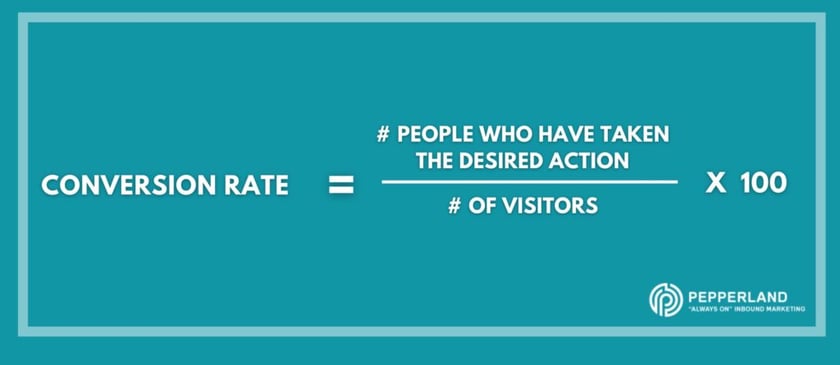
8. Cost Per Lead (CPL)
Cost Per Lead (CPL) is fairly self-explanatory; this KPI measures how much money is spent on content marketing to generate a single lead.
CPL is an important metric as it allows you to determine if your content marketing strategy is cost-effective. A low CPL is representative of an efficient and successful strategy. If your CPL is particularly high, your content might not be reaching the right audience, and if it is reaching the right audience then it might be an issue of quality.
Your Cost Per Lead will vary by your industry and budget.
How to Calculate Cost Per Lead:
To calculate your Cost Per Lead, simply divide the total amount spent on content marketing divided by the number of leads you’ve generated.
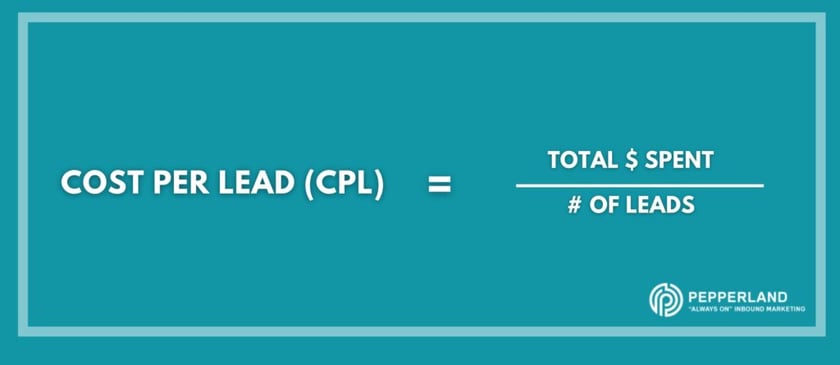
9. Content Marketing ROI
Your Return on Investment, or ROI, is a measure of how much revenue you’ve generated through your content marketing efforts in comparison to how much you’ve spent.
ROI is an essential content marketing KPI because it tells you if your content marketing efforts were profitable.
A solid ROI will help you to justify future content marketing efforts to senior management, and perhaps increase your budget. A poor ROI might alert you of issues regarding the quality of your content or the efficiency of your team.
How to Calculate Content Marketing ROI:
To calculate the ROI of your content marketing efforts, first, subtract your costs from the revenue your content generated. Then, divide that number by your costs and multiply by 100.
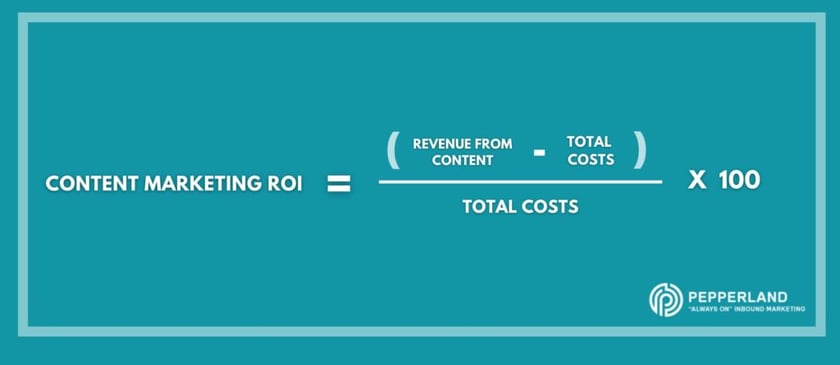
Driving Results with KPIs
These are just a few of the many content marketing KPIs that exist. Choose the metrics that make the most sense for your organization and use them to develop SMART goals for your strategy.
To track your progress toward your goals and monitor any changes in your KPIs, we recommend that you integrate your Google Analytics and HubSpot accounts with a tool like Databox to automatically track your performance with a customizable dashboard.
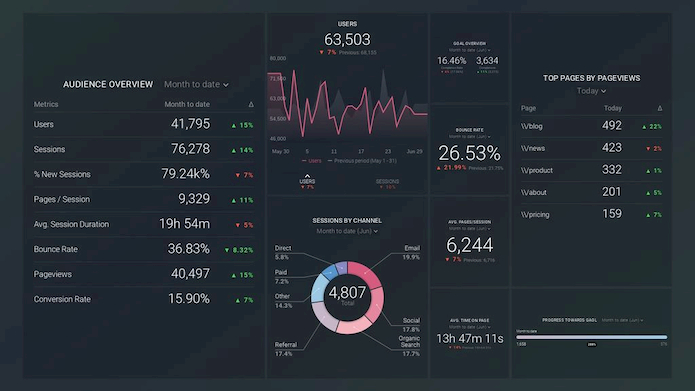
By identifying the appropriate KPIs for your content marketing goals and consistently monitoring your progress, your efforts are more likely to be successful and profitable for your organization.
Download our free SMART marketing goal-setting template to set your content marketing goals using the KPIs that you’ve selected.







